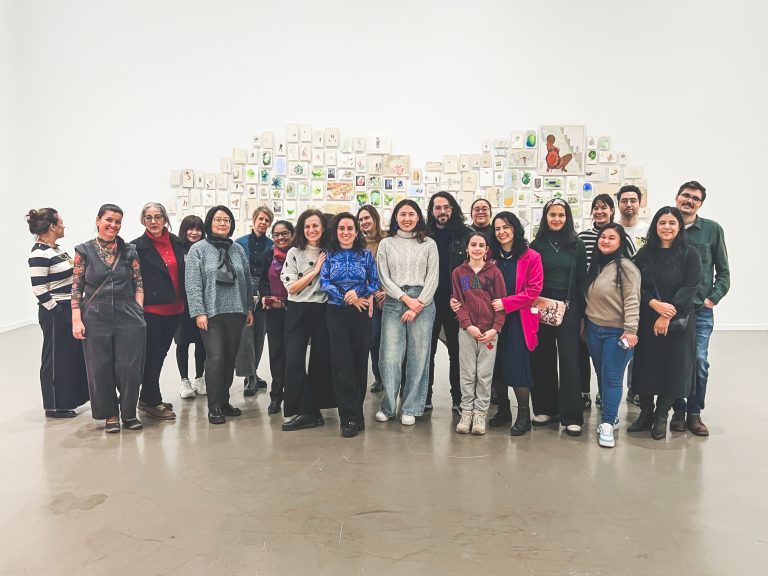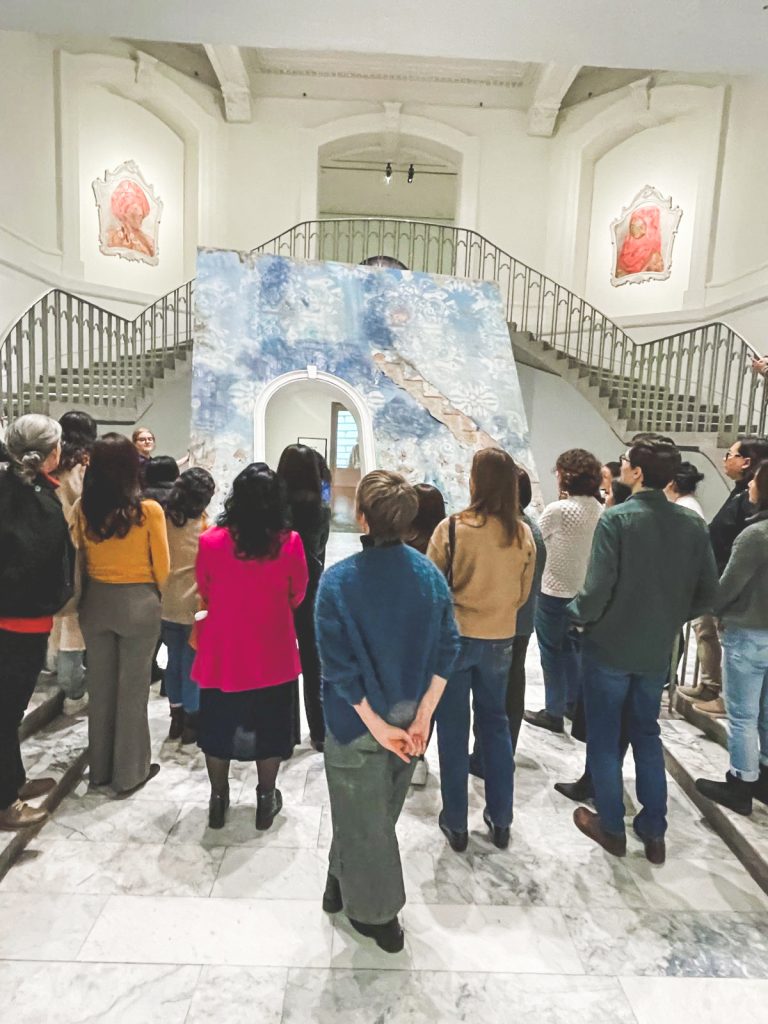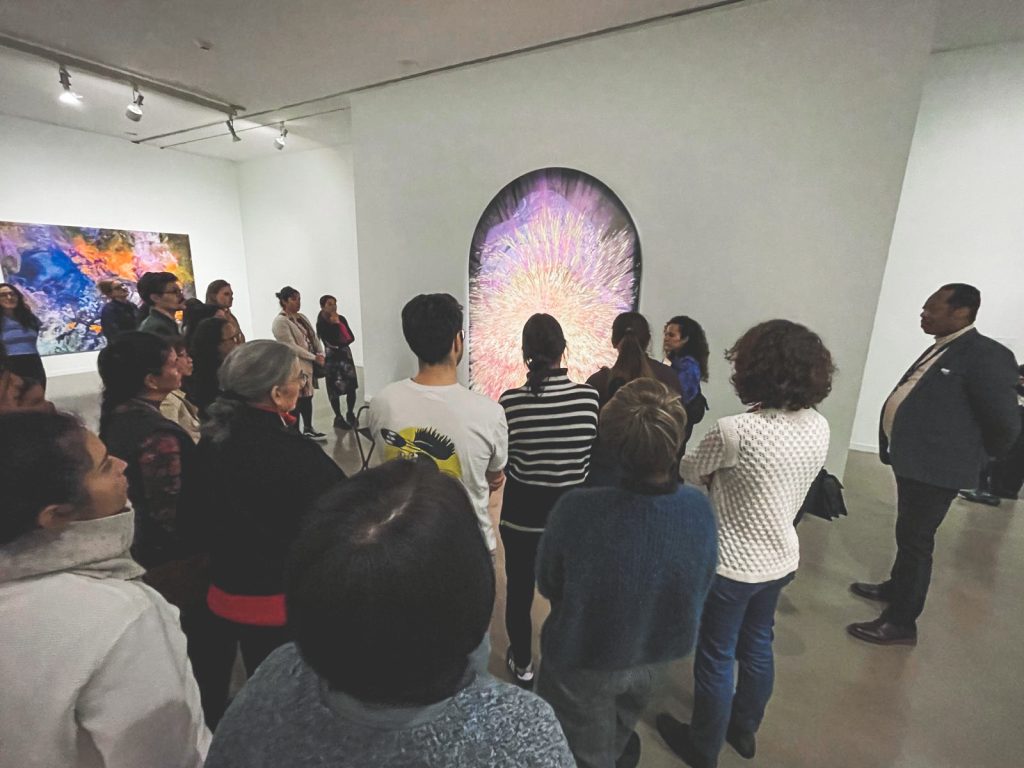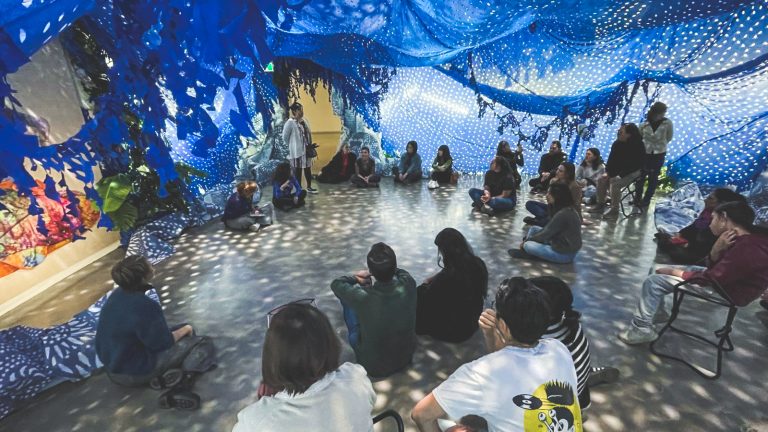
The power of art is to lower one’s ground. To help you connect, and I find that there is something radical about connecting.
Firelei Báez
January 21, 2025 | Vancouver Art Gallery
There’s something profoundly transformative about stepping into Firelei Báez’s world of vibrant color and textured narrative, where the boundaries between history, identity, and cultural memory begin to blur. As a Latin American artist whose work often challenges the erasure of histories—particularly those of the Caribbean and Afro-Latinx communities—Firelei’s art offers us an invitation to reimagine the past and rethink the present. Her canvases are not just visual statements; they are rich with stories that stretch across time, geography, and culture, urging us to examine the ways history has been constructed and, just as importantly, how it continues to shape our future.
On January 21, 2025, I had the privilege of co-leading a community tour through the Firelei Báez exhibition at the Vancouver Art Gallery (VAG) thanks to a collaboration between the VAG and the Vancouver Latin American Cultural Centre (VLACC). It was a deeply meaningful experience for me, both personally and professionally, as I was able to connect with fellow Latin Americans, women artists, and a diverse community of art lovers while exploring works that spoke so strongly to my own heritage.
I’m incredibly grateful to Stephanie Bokenfohr, Public Programs Coordinator at VAG, for co-leading this tour with me. Her familiarity with Firelei’s work, combined with her ability to connect with the audience, was a vital part of the tour’s success. She made sure to weave in additional context and insights, enriching the experience for everyone present. I also want to express my heartfelt thanks to Lili Vieira de Carvalho, Executive Director of VLACC Thaís Bouez, Programming Coordinator at VLACC for making this event possible, ensuring we could gather around art that reflects and amplifies our shared histories and experiences.
The artworks in Firelei’s exhibition speak to the gaps in official histories—particularly those of marginalized peoples—by inviting us to acknowledge and reimagine the voices and stories that have been sidelined. Each piece reflects her exploration of the intersections of identity, memory, and resistance, all while navigating the complexities of her own cultural heritage as a Dominican artist.
Throughout the tour, I encouraged the group to slow down and truly look at the works. Firelei’s titles are critical to understanding the layers of meaning within her paintings, so I asked questions like: “What do you recognize here?” “What feelings come up when you see this work?” By validating the responses of our group, we created a safe and open space to engage with the works, allowing us all to discover something new with each step.

We began our journey with this monumental piece, one of Firelei’s most striking works. The title itself is bold, unapologetic, and reflects the artist’s desire to question the status quo. (once we have torn shit down, we will inevitably see more and see differently and feel a new sense of wanting and being and becoming), 2014 is a reference to Sans Souci, both to Jean-Baptiste Sans Soui and the palace in Haiti which holds significant historical weight as a symbol of revolution and the complex relationship between the Haitian people and their colonial past. The piece itself is a dynamic composition of acrylic, gouache, sheetrock, and steel, its form inviting the viewer to engage not just visually but emotionally.
As I guided the group through the work, I encouraged a moment of “slow looking,” where we explored the intricate damasks composed with Firelei’s recurrent iconography featuring the azabache hand and the afro pick comb. Surrounded by the Neo-classical architecture of the Gallery, Firelei’s work acquired further levels of reading. I pointed out the Rococo swirls that wrap around the plaster frames of the two portraits above the rotunda’s staircases, referencing both the luxurious and violent aspects of colonial history. Firelei’s work offers a radical invitation to connect with the complexities of history and to imagine new possibilities for the future.

From the main rotunda we moved to Madeleine (Rupture Rapture Maroonage), a painting that reimagines Portrait of Madeleine by Marie-Guillemine Benoist, originally known as Portrait of a Negress. This work draws us into a painful yet necessary excavation of history. Firelei’s depiction of Madeleine challenges the reductive narrative presented in the original portrait, reclaiming agency and dignity for the figure who, in many ways, was erased from historical memory.
Firelei’s words, “I would hope that all the different facets of the exhibitions can act like doorways to different journeys… to fill your love arsenal for the world,” resonated with the group as we discussed how the painting invites us to look beyond the surface and understand the complexity of the historical forces at play.
In this next stop, Untitled (Terra Nova), Firelei once again pushes us to reconsider borders—not only geopolitical but also the ideological boundaries that have defined our understanding of history. By painting over maps, Firelei disrupts the authority of those very boundaries, showing us that the landscape of the Americas, Africa, and Europe is not as fixed as we might believe. It’s a powerful reflection on colonialism, migration, and the intertwined histories of continents often divided by arbitrary lines.
As we moved to this piece, I invited the group to reflect on Firelei’s use of pouring techniques as markers of time and space. Tone Tonal Time is not just a painting; it is a living, breathing expression of Firelei’s own experiences. It evokes historical painting traditions while also breaking free from them, allowing us to understand the artist’s personal history while simultaneously confronting broader cultural narratives. The scale of the work, combined with its virtuosity, made it a perfect moment to discuss how Firelei’s figures dominate the canvas, often reclaiming space that was once denied to them in traditional historical art.

As we sat inside this powerful work, our group took the time to reflect on its rich layers. The discussion was deeply engaging, with participants connecting the work to broader histories of struggle, survival, and resistance. The room itself felt charged with energy, and the insights shared by the audience made this moment particularly resonant. This piece isn’t just about the past—it’s a call to envision new futures, much like the Drexcyen collective did with their music, proposing an Afrofuturist vision of liberation and community beyond the historical limitations.
A Drexcyen Chronocommons (To Win the War You Fought It Sideways) invited us into the night sky of the Haitian Revolution, where the tiny pinholes map out the stars as they appeared on that momentous night. As Firelei explains, “The marker of tropical storms was always blue tarpaulins,” and this installation, though symbolizing shelter, also suggests the disaster that shelter must sometimes withstand. This juxtaposition of resilience and destruction gave our group much to discuss, as we reflected on the connections between historical movements, the passage of time, and the struggle for autonomy.
Linyon was a beautiful and poignant moment in the tour, as we examined how Firelei’s work continuously offers a new lens through which to view both oppression and strength. The title, which translates to “The oppressive forces of the past become fragile and weakened,” speaks to a collective hope for liberation and the ongoing process of dismantling systems of oppression. The work also provided an opportunity to reflect on how symbols of resistance, like the figa fist, were used by enslaved people as a subtle form of defiance. Originally a gesture of protection or good luck, the figa—with its thumb tucked between the index and middle fingers—could also have been employed covertly to signal resistance, desire, or even sexual autonomy in the face of oppression. In Firelei’s exploration of historical and symbolic power, this connection felt especially relevant, reminding us that even under extreme conditions, enslaved people found ways to reclaim their agency, express strength, and challenge the forces that sought to control them.
To close our tour, we arrived at Sans-Souci, a piece that references the Haitian palace of the same name, symbolizing the complex history of revolution, colonialism, and the struggle for freedom. The title, “This Threshold Between a Dematerialized and a Historicized Body,” reflects the interplay between personal and collective history, and how both are often erased from official narratives, only to be reinterpreted through acts of resistance and reclamation.
Firelei’s use of the Sans-Souci palace speaks to the resilience of the Haitian Revolution and the broader history of Black resistance. The work invites us to reconsider symbols of oppression, turning them into emblems of strength and empowerment. This resonates with the story of the tignon law in Louisiana, which required Black women to cover their hair in public. Initially intended to segregate and control, the law backfired as Black women began to adorn their tignons in creative, elaborate ways, turning a tool of oppression into an expression of cultural pride and resistance.
In the same spirit, Sans-Souci challenges us to rethink history and its symbols. Firelei redefines the narrative, urging us to see the struggle for freedom not just as a historical fact but as an ongoing process of resistance and self-determination. Her work asks us to consider how we, too, can reimagine the symbols of power in our own lives and transform them into vehicles for liberation and strength.
As Curator Eva Respini states, Firelei Báez is undoubtedly one of the most important voices in contemporary painting today. Her work is both enchanting and thought-provoking, creating a space where difficult histories can be confronted, celebrated, and re-envisioned. As we wrapped up our tour, I reflected on how Firelei’s art creates a space for the reclamation of history—especially for those whose stories have long been sidelined.
Thank you to everyone who joined us for this immersive journey through Firelei’s world. Your reflections, conversations, and engagement made this tour truly special. 📸 by Lili Vieira de Carvalho and Natasha Ponda
We’ll continue the conversation on March 8, 2025, during a panel I will be moderating at the Vancouver Art Gallery, where we’ll dive deeper into the themes of Firelei’s work, as well as the significance of history, identity, and resistance in contemporary art. I hope to see you there! – Miret